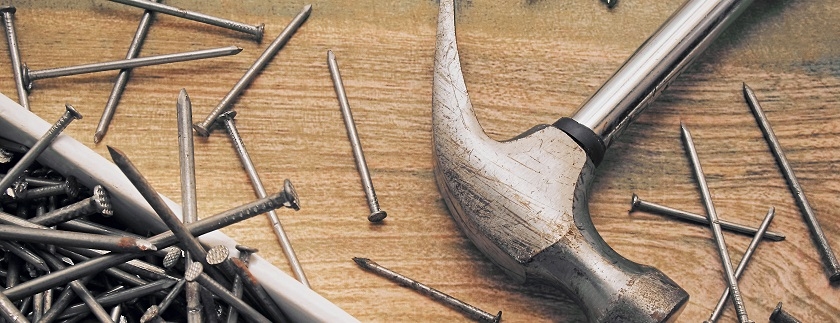A hammer is a particularly versatile tool that works to drive in and remove nails and can be used as a wrecking tool. However different hammers have been designed for specific jobs. This guide takes you through a variety of hammers available and their purpose.
Claw Hammers
Claw Hammers are used for both lightweight or heavy-duty fixing purposes, depending on the weight and the quality. The claw is designed to remove nails and prize away materials such as wood. It’s likely that this will feature in a standard toolbox as it’s the most versatile of all hammers. With that in mind it’s a good idea to invest in a quality hammer with an ergonomically shaped handle so that you’re comfortable using it for multiple jobs.
Ball-peen Hammers
Also known as a ball hammer, ball-pein hammers are mainly used for metalwork. It is designed for driving cold chisels, punches, and for riveting, shaping, and straightening metal and peening the end of metal tubes.
Scutch Hammers
Scutch hammers are designed for knocking (scutching) off old mortar from bricks and paving. It can also be used for splitting bricks, tile, and concrete blocks. The surfaces are hardened and tempered, and the grips are designed for hard-hitting work despite these hammers being comparatively small. They have a long thin peen which helps get between the mortar and the bricks, a bit like a chisel.
Continental Hammers
The head of this hammer has a cross-peen design with a flat and square striking face and a wedge-shaped peen.
Drywall Hammers
Designed specifically for fixing plasterboard when drylining or before plastering. The flattened peen is used to tuck in trimmed edges of board.
Pin hammers
This is a very lightweight hammer, used to knock in small fixings such as panel pins and tacks. Often used in haberdashery or delicate woodwork.
Wooden Mallets
Commonly used in carpentry to knock wooden pieces together, or to strike a chisel. A wooden mallet is softer than a metal hammer and absorbs some of the force. Its also easier to strike a chisel accurately with a mallet because the face is larger. The broad, slightly angled face is designed perfectly for hitting smaller areas such as the chisel.
Rubber Mallets
Rubber mallets are used alongside a chisel, normally in woodwork. A metal hammer might break the handle of some chisels whereas a rubber mallet will absorb any reverb, thus driving force without breaking the subject. The chisel offers the accuracy, the hammer offers the force. It’s the most used mallet around the world. Rubber mallets are also useful for hammering in tent pegs.
Club Hammers
Also called a lump hammer, club hammers are the heaviest hammer that can be used with one hand. It has a large striking face and is commonly used with a bolster chisel or a cold chisel to split bricks. It can distribute force over a wider area than other hammers. It can also be used for driving large masonry nails into walls.
Sledgehammers
Sledgehammers are a larger type of club hammer that can be used to break up masonry surfaces such as brick, breezeblocks, or paving. Often used to knock down interior walls or knocking in posts, the long handle allows you to use gravity for additional force. Ensure you are wearing appropriate safety gear when using a sledgehammer such as a hard hat, steel toe-capped boots, gloves and goggles.
Specific job-based hammers
Some hammers are designed for specific jobs, such as a brick hammer or joiner hammer. The brick hammer for instance, is designed with one flat face and a short or long chisel-shaped blade which is used to chip off edges or small pieces of stone. Brick hammers are often used by stonemasons.
Joiner hammers (also known as Warrington Hammers) are made specifically for cabinet-making, with a cross peen that is used to start brads or finishing nails without the risk of damage to fingers, and a belled head to let you drive nails flush to the surrounding wood.
View our full range of hammers and mallets here.



